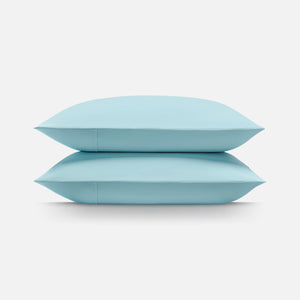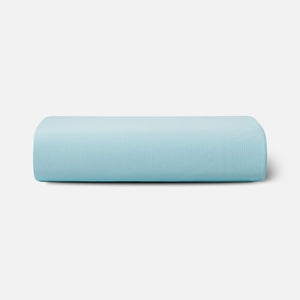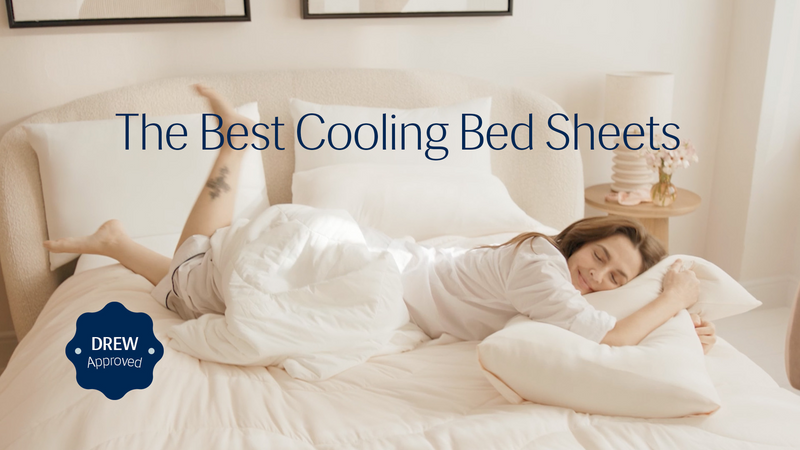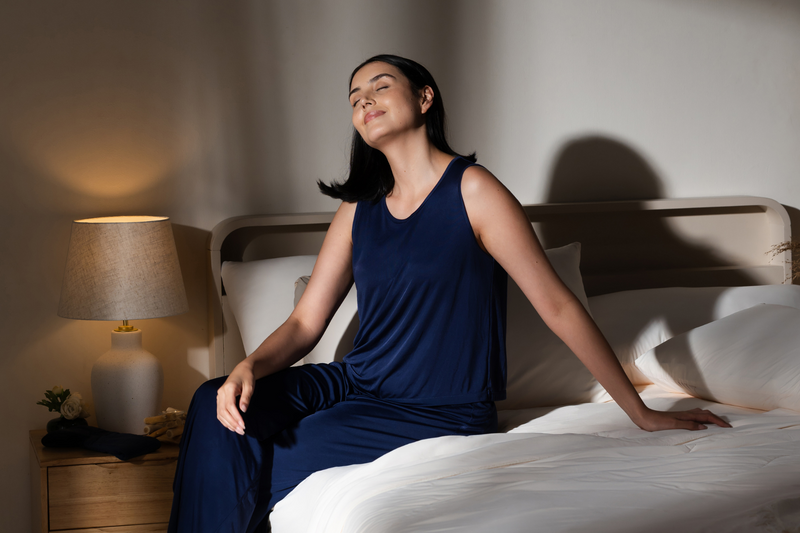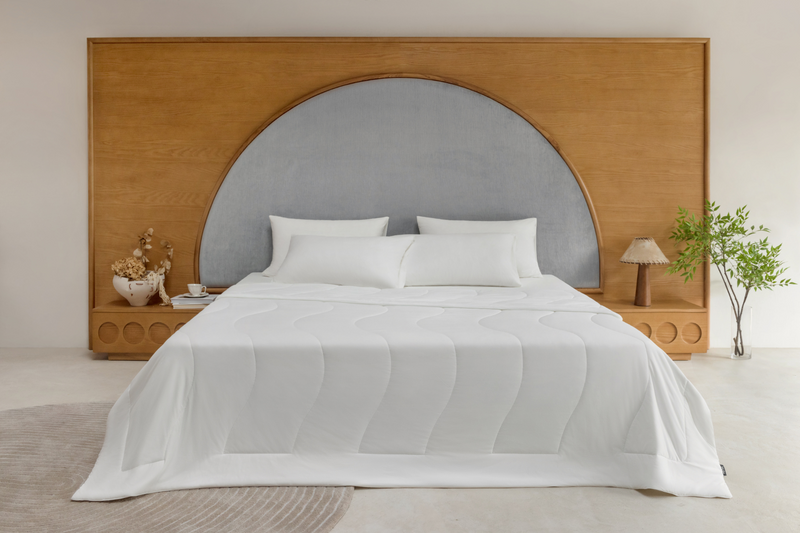How to Choose Bed Sheets for Optimal Comfort and Durability
Buying new bed sheets should feel like an upgrade rather than a challenge. But with so many fabrics, thread counts, and textures to pick from, it's easy to become overwhelmed. Should you pick clean cotton, airy linen, or something high-tech and cool?
At Rest, we've witnessed firsthand the impact that the best bed sheets can have. Whether you choose breezy coolness or comfortable softness, a well-designed set like the Evercool®+ Cooling Sheet Set provides a variety of bed sheets to improve your sleep in more ways than one.
This guide breaks down why good sheets matter and what truly matters when choosing the right bed sheets so you can sleep better, longer, and cooler.
Why Good Sheets Matter More Than You Think
Before we go into thread counts and fabric varieties, let's talk about why investing in decent sheets is important. Quality sheets:
-
Help regulate body temperature
-
Minimize irritation for sensitive skin
-
Offer durability over time (fewer replacements = less waste)
-
Contribute to better hygiene
-
Complete your sleep environment with style
The appropriate bedding can also affect how much you toss and turn in your sleep. If you're hot or tangled in scratchy fabric, your body won't enter deeper phases of relaxation.
How to Choose Bed Sheets for Optimal Comfort

1. Fabric Types
Sheets come in a variety of fabric types, which influence comfort, durability, breathability, and cost. Understanding these materials allows you to select the most appropriate sheet for your needs.
Evercool® Cooling Fabric is super soft and made to last. It pulls away heat and sweat quickly to help you stay cool and dry all night. The fabric also has special silver ions that stop germs from growing, so your sheets stay fresh for longer. It dries fast and feels light and cool against your skin. With Evercool® Cooling Fabric sheets, your sleep stays clean, comfy, and cool.
Cotton is the most preferred choice. It is a natural fabric valued for its softness, strength, and breathability. Premium cotton varieties include Egyptian and Pima (or Supima) cotton, which have longer fibers and result in smoother, more durable sheets. Lower-grade cotton, such as upland cotton, is less expensive but less durable. Organic cotton tends to be more expensive owing to its cultivation practices.
Bamboo sheets are created from bamboo pulp that is converted into viscose or rayon fabric. They are soft, silky, and effectively control temperature. Bamboo is widely regarded as environmentally beneficial since it grows swiftly and requires few resources. However, the chemical method used to manufacture bamboo viscose may have negative environmental consequences.
Tencel, generated from eucalyptus trees, is a form of lyocell fabric comparable to bamboo viscose but produced in a more ecologically friendly manner. Tencel sheets have a smooth, cool feel and moisture-wicking characteristics, making them desirable for bedding.
Polyester, a synthetic textile, is noted for its durability and affordability. It is wrinkle-resistant and moisture-wicking, making it ideal for hot sleepers. Pure polyester sheets might feel harsh or less breathable; therefore, cotton mixes are commonly used to increase comfort.
Silk is a protein fiber made by silkworms. It creates a lovely, smooth surface that is both breathable and cool. Silk bedding frequently improves hair and skin by decreasing friction. They are measured using momme weight, which shows fabric thickness and quality. Silk manufacturing raises ethical difficulties because of how silkworms are treated.
Linen is made from flax fibers and has been used for thousands of years. Due to its hollow fibers, it outperforms cotton in terms of durability and breathability. Linen sheets feature a rough surface and a loose weave, which promotes ventilation. Pure linen might be expensive, but mixes provide more inexpensive choices.
2. Construction Styles: Weaves and Knits
The way fibers are woven or knitted into fabric has a significant impact on the texture, durability, and breathability of your sheets.
Percale is a plain weave with a basic one-over-one-under pattern. It produces a clean, smooth surface with a matte finish. Percale is lightweight and breathable, so it's great for those who want cool, crisp bedding. Its decreased thread count increases ventilation, decreasing heat accumulation at night.
Sateen weave employs a unique technique in which many threads travel over one another in a pattern that results in a smooth, lustrous surface. This weave produces a cloth with a silkier texture and slightly more weight. Sateen sheets are soft and have a beautiful shine, although they might retain more heat than percale.
Jersey knit is more like a flexible fabric, made by looping strands. It feels smooth and comfy, like a cotton T-shirt. Jersey knit sheets are breathable, yet more elastic and less rigid than woven sheets.
Flannel creates a fuzzy, warm surface by a combination of weaving and brushing. Flannel bedding is ideal for chilly locations or those seeking additional warmth and comfort on cold evenings.
| Weave Type | Texture | Breathability | Best For |
|---|---|---|---|
| Percale | Crisp, matte | High | Hot sleepers |
| Sateen | Smooth, glossy | Medium | Those who want silky softness |
| Jersey | Soft, stretchy | Medium | Casual, cozy feel |
| Flannel | Fuzzy, warm | Low to Medium | Cold weather |
Your total sleeping comfort and durability are determined by the material you choose for your sheet, as well as the weave or knit type. Both components work together to shape how your sheets appear and feel over time.
3. Proper Size and Fit
Make sure your sheets are the right size for your mattress, whether it's twin, full, queen, or king. Pay specific attention to the pocket depth of fitted sheets, especially if your mattress is thicker than conventional sizes. Deep pockets that extend a few inches beyond mattress height offer a secure fit and prevent sliding.
4. Style and Shades
Choose colors and patterns that complement your room's decor. Neutral tones such as white, gray, or beige provide timeless styles, while subdued pastels or vibrant hues make strong impressions. Brands differ in their offers, so start your search with those that provide your desired color palette or print style.
5. Thread Count Considerations
Thread count represents the number of threads per square inch; however, it does not always imply higher quality. Aim for a thread count of 180 to 300 on percale sheets and 300 to 600 on sateen textiles. High numbers outside this range may include multi-ply threads, which do not ensure improved comfort.
| Fabric Type | Recommended Thread Count |
|---|---|
| Percale | 180 - 300 |
| Sateen | 300 - 600 |
| Silk, Jersey, Flannel | Not measured by thread count |
6. Temperature Control
Are you a hot sleeper? Choose lightweight, breathable fibers such as cotton, linen, and Tencel. Unless you live in a chilly environment, avoid using fabrics that are too thick or heavy.
Consider using breathable sheets in conjunction with a comforter made for warmer evenings to maximize cooling. The Evercool®+ Cooling Starter Sheet Set is an excellent choice, since it is made of special cooling fabric that wicks sweat and regulates temperature throughout the night. It is even pet-friendly and machine-washable.

7. Maintenance Tips
Sheet maintenance varies according to fabric. Cotton and synthetic mixes are often machine washable and simple to maintain. More delicate textiles, such as silk, need gentler care, including hand washing or specific detergents. Check care labels to keep your bedding in good condition for longer.
8. Budget and Cost Range
Sheets are available in a wide variety of prices, from budget-friendly alternatives around $50 to quality picks that may cost more than $300 for queen-size sets. Natural luxury textiles, such as silk and linen, attract greater costs. Cotton and bamboo are mid-range alternatives, although polyester and mixes are frequently more economical. Set a budget before going shopping to help you reduce your options efficiently.
9. Types of Sheets?
There are a few essential types you’ll want to know:
-
Flat Sheet: A top layer between you and your comforter.
-
Fitted Sheet: The snug-bottom sheet with elastic edges.
10. Sets or Individual Sheets
Some people prefer buying full sets that include a fitted sheet, flat sheet, and pillowcases. Others may just need individual pieces to mix and match or replace worn-out items. Buying individual sheets can also give you more flexibility in style and fit, especially if you use different-sized pillows or have a non-standard mattress.
Final Thoughts
Your bed sheets may make or break your sleep quality. Choose intelligently by emphasizing feel, function, and fit above flashy figures or phrases. Whether you sleep hot, are a minimalist, or simply want ultra-soft sheets that last, the appropriate fabric and structure make all the difference.
Do you want the best of both worlds: a luxurious feel and modern functionality? Consider the Rest.com's Evercool®+ line. Their sheets have perfected the formula for sheets that truly improve your sleep, from individual flat or fitted sheets to whole sets engineered for cooling, comfort, and longevity.
